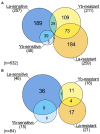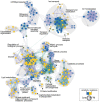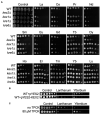Genome-Wide Mutant Screening in Yeast Reveals that the Cell Wall is a First Shield to Discriminate Light From Heavy Lanthanides
- PMID: 35663896
- PMCID: PMC9162579
- DOI: 10.3389/fmicb.2022.881535
Genome-Wide Mutant Screening in Yeast Reveals that the Cell Wall is a First Shield to Discriminate Light From Heavy Lanthanides
Abstract
The rapidly expanding utilization of lanthanides (Ln) for the development of new technologies, green energies, and agriculture has raised concerns regarding their impacts on the environment and human health. The absence of characterization of the underlying cellular and molecular mechanisms regarding their toxicity is a caveat in the apprehension of their environmental impacts. We performed genomic phenotyping and molecular physiology analyses of Saccharomyces cerevisiae mutants exposed to La and Yb to uncover genes and pathways affecting Ln resistance and toxicity. Ln responses strongly differed from well-known transition metal and from common responses mediated by oxidative compounds. Shared response pathways to La and Yb exposure were associated to lipid metabolism, ion homeostasis, vesicular trafficking, and endocytosis, which represents a putative way of entry for Ln. Cell wall organization and related signaling pathways allowed for the discrimination of light and heavy Ln. Mutants in cell wall integrity-related proteins (e.g., Kre1p, Kre6p) or in the activation of secretory pathway and cell wall proteins (e.g., Kex2p, Kex1p) were resistant to Yb but sensitive to La. Exposure of WT yeast to the serine protease inhibitor tosyl phenylalanyl chloromethyl ketone mimicked the phenotype of kex2∆ under Ln, strengthening these results. Our data also suggest that the relative proportions of chitin and phosphomannan could modulate the proportion of functional groups (phosphates and carboxylates) to which La and Yb could differentially bind. Moreover, we showed that kex2∆, kex1∆, kre1∆, and kre6∆ strains were all sensitive to light Ln (La to Eu), while being increasingly resistant to heavier Ln. Finally, shotgun proteomic analyses identified modulated proteins in kex2∆ exposed to Ln, among which several plasmalemma ion transporters that were less abundant and that could play a role in Yb uptake. By combining these different approaches, we unraveled that cell wall components not only act in Ln adsorption but are also active signal effectors allowing cells to differentiate light and heavy Ln. This work paves the way for future investigations to the better understanding of Ln toxicity in higher eukaryotes.
Keywords: cell wall; deletome; endocytosis; lanthanum; signaling; ytterbium.
Copyright © 2022 Grosjean, Le Jean, Chalot, Mora-Montes, Armengaud, Gross and Blaudez.
Conflict of interest statement
The authors declare that the research was conducted in the absence of any commercial or financial relationships that could be construed as a potential conflict of interest.
Figures








References
LinkOut - more resources
Full Text Sources
Molecular Biology Databases

